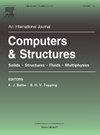Hierarchical element integration technique in discrete element simulation of rock failure
IF 4.8
2区 工程技术
Q1 COMPUTER SCIENCE, INTERDISCIPLINARY APPLICATIONS
引用次数: 0
Abstract
Discrete element method has a congenital advantage over the continuous numerical methods for simulating the damage and fracture of geo-materials, as its calculation principles align with the discontinuous nature of these materials. Due to the unclear relationship between element scale and element strength (size effect), the element parameters, especially for the field-scale model, are quite hard to be reasonably determined, causing computational efficiency and accuracy cannot be balanced. To address this issue, the hierarchical scaling size effect model was developed to characterize the relationship between the strength and size of rock material. Based on which, an element integration technique was proposed that achieves a match between element strength and size. Discrete element simulations of laboratory tests demonstrated that, compared to the grain-based model (GBM), the calculation accuracy is maintained while the number of elements can be reduced by 2 to 3 orders of magnitude, indicating more than 100-fold improvement in calculation efficiency. This element integration technique was also employed in the simulation of field-scale hydraulic fracturing to demonstrate its feasibility in capturing the failure evolution in rock mass from a few centimeters to tens meters. Additionally, the mechanism of fault slip induced by hydraulic fracturing was roughly discussed.
岩石破坏离散元模拟中的分层元积分技术
离散元法的计算原理与土工材料的不连续特性相一致,在模拟土工材料损伤与断裂方面具有连续数值方法所不能比拟的先天优势。由于单元尺度与单元强度之间的关系不明确(尺寸效应),单元参数难以合理确定,特别是对于场尺度模型,导致计算效率和精度无法平衡。为了解决这一问题,建立了分级尺度效应模型来表征岩石材料的强度与尺寸之间的关系。在此基础上,提出了一种单元集成技术,实现了单元强度与尺寸的匹配。实验室试验离散元模拟表明,与基于颗粒的模型(GBM)相比,在保持计算精度的同时,单元数可减少2 ~ 3个数量级,计算效率提高100倍以上。该单元集成技术还应用于现场尺度的水力压裂模拟,验证了其在捕捉岩体从几厘米到几十米的破坏演化过程中的可行性。并对水力压裂诱发断层滑动的机理进行了初步探讨。
本文章由计算机程序翻译,如有差异,请以英文原文为准。
求助全文
约1分钟内获得全文
求助全文
来源期刊

Computers & Structures
工程技术-工程:土木
CiteScore
8.80
自引率
6.40%
发文量
122
审稿时长
33 days
期刊介绍:
Computers & Structures publishes advances in the development and use of computational methods for the solution of problems in engineering and the sciences. The range of appropriate contributions is wide, and includes papers on establishing appropriate mathematical models and their numerical solution in all areas of mechanics. The journal also includes articles that present a substantial review of a field in the topics of the journal.
 求助内容:
求助内容: 应助结果提醒方式:
应助结果提醒方式:


